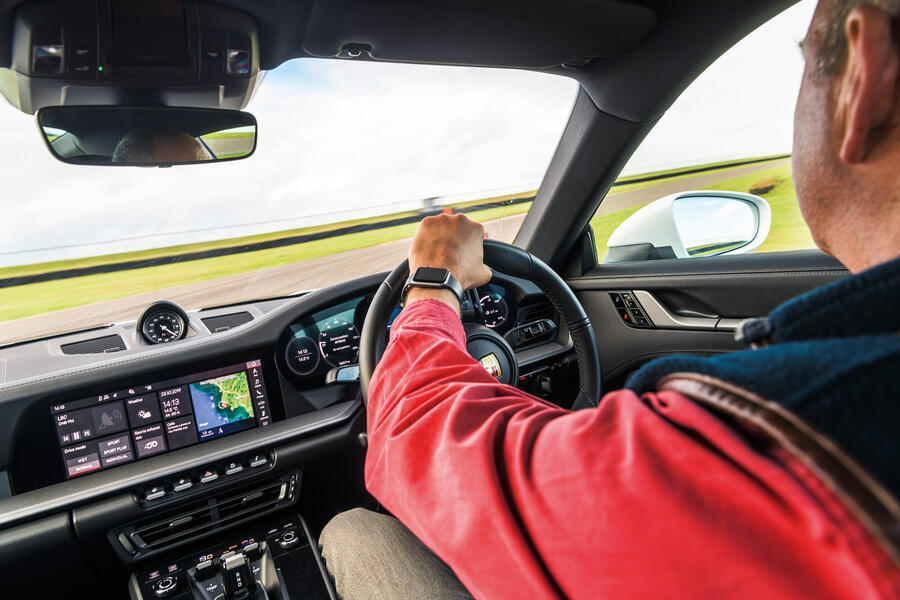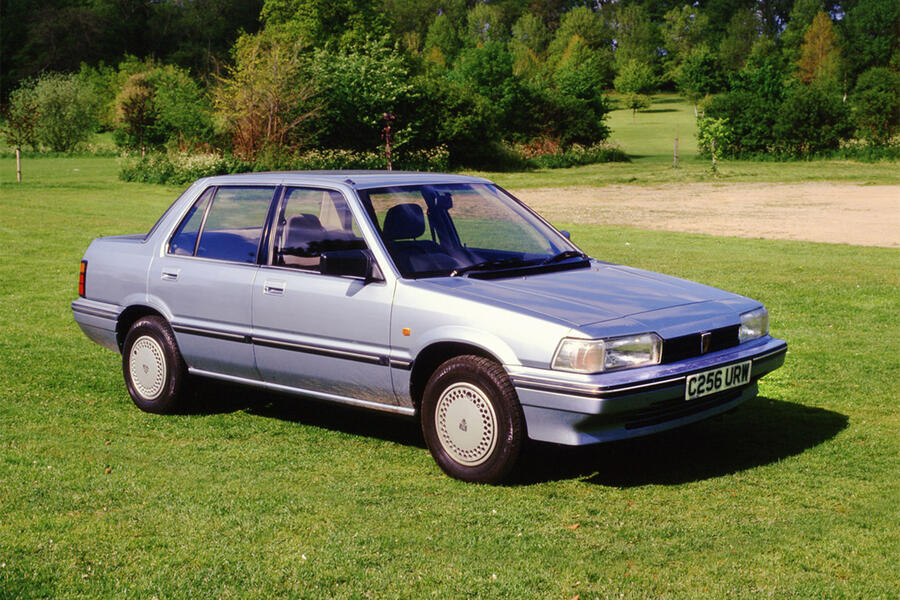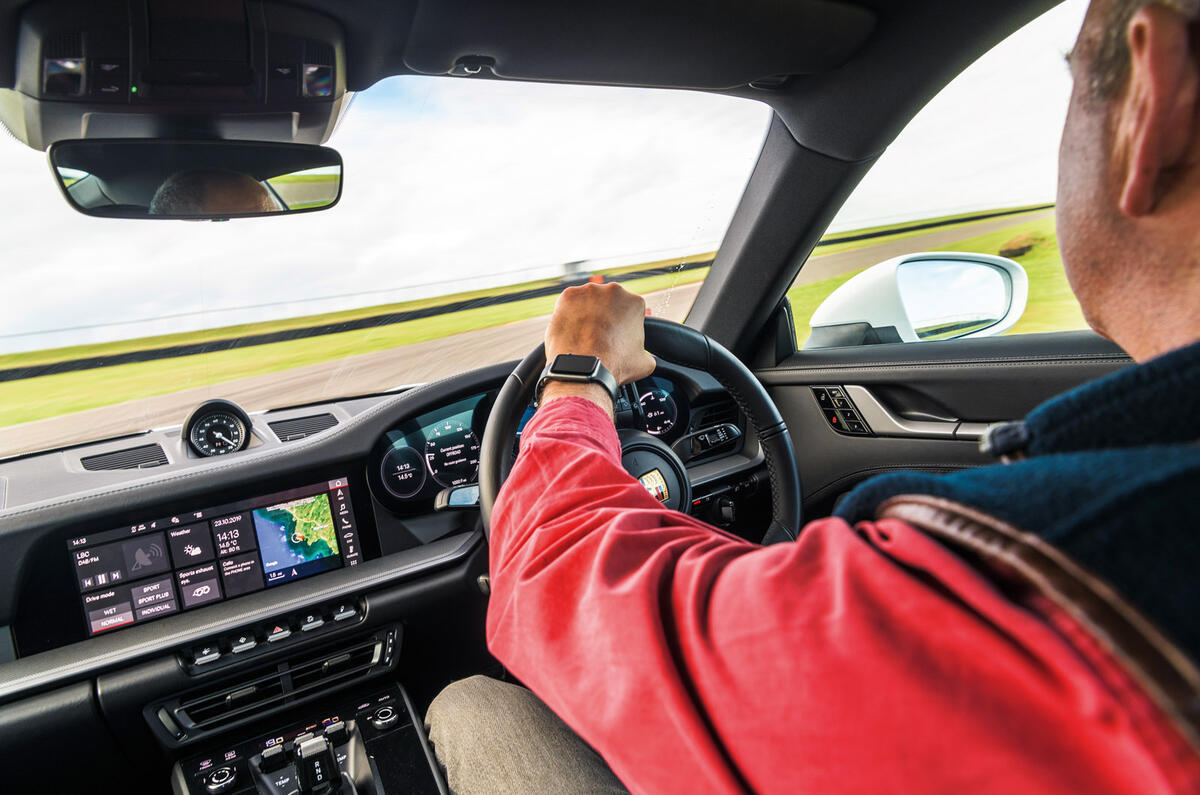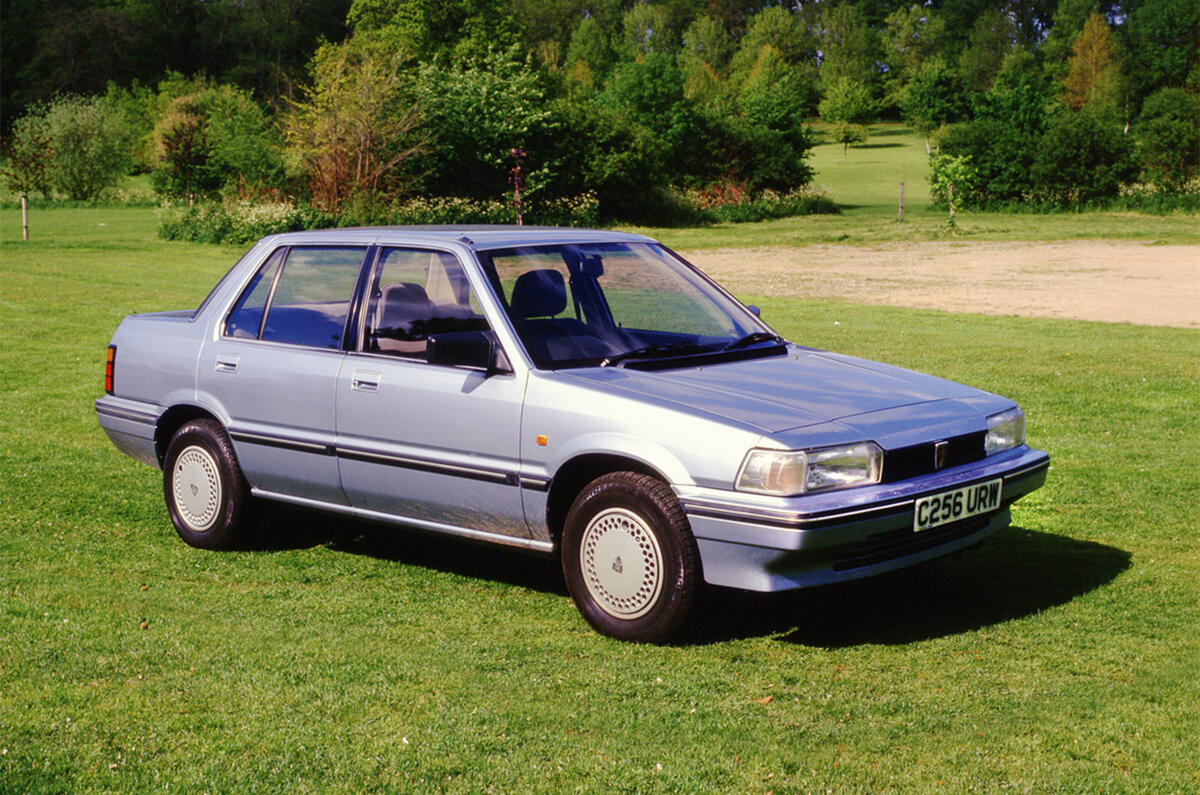The white Porsche 911 angles into the turn. It’s a quick corner, top end of third gear, but instead of gently coaxing it into the apex, managing its mass and keeping the loaded tyres within the circle of adhesion where longitudinal and lateral forces haggle eternally for grip, the driver sharply lifts and then flattens the throttle. Instantly the car is sideways.
It wants to spin, but the driver catches the fast-moving tail with the steering. But no attempt at recovery is made. Instead the foot stays down, the tail stays out, now towing a ball of super-heated, atomised rubber particles. Yet it still finds the apex and still finds the exit before snapping straight and howling away up the straight beyond. A few minutes later its driver brakes the car to a halt in the pit lane, lowers the window and says to anyone listening: “That is what I call handling.”
And I suspect neither you nor I would have much truck with that. But just because it’s true doesn’t mean that’s the whole truth or, as I shall seek to show, even very much of it. What follows is my attempt to describe what handling actually is – and for the most part it has very little to do with the terrible twins of oversteer and understeer – and what qualities need to be engineered into a car in order to provide it.
At its heart, handling is not measured by a car’s ability to powerslide until its tyres melt but by something far more simple and precious: the ability of a car to execute the instructions of its driver.
If that sounds like a statement of the obvious, then you are one up on those chassis engineers the world over whose efforts fail in this simplest regard. To see what I mean, take your car to a quiet roundabout, apply what you judge to be the requisite steering lock to negotiate it and don’t move your hands. Normal road speed is fine. Does it go where you thought you’d pointed it? If so, can you continue to lap said constant-radius roundabout without moving the steering wheel? If the answer to either question is ‘no’ then your car is not going where you want it to. It is not executing your instructions.
![]()
You’d be amazed by how many cars cannot perform this apparently simplest of tasks. When I first started doing this job more than 30 years ago, I was tutored in precisely this phenomenon by none other than former Formula 1 driver, Jim Clark team-mate and Autocar columnist John Miles; I was staggered by how imprecise and inaccurate most normal road cars were. Over the years that followed cars did get a lot better as chassis structures gained rigidity, suspension became more sophisticated and tyre sidewalls flexed less, but in this modern era of electric steering systems, where traditional ‘feel’ has been largely eradicated, combined with variable-ratio racks that give varying outputs to the same input according not only to steering angle but also and often to road speed, knowing exactly where you’re pointing a tonne-and-a-bit of fast-moving metal is in fact becoming harder once again.
But there are elements of handling more basic even than that, and just as often still got wrong. Take the humble steering wheel. Just think, for a moment, what it has to do. It must interact with other components mentioned above (structure, suspension, wheels and tyre) and, if a car is to handle predictably, be as linear in its actions as possible. But it must also be correctly geared: too slow and you’ll be whirling your arms uncomfortably and, should the car slide, it’ll take longer to catch. But too fast and the car will feel horribly nervous, even in a straight line, and when it slides you will need greater accuracy in order to catch it. It must also be correctly weighted for reasons I don’t think I need to explain, and both on- and off-centre.
Is that it? Not even close. The wheel must be positioned such that even quite unconventionally proportioned drivers can place it where it is comfortable, where it does not obscure the instruments and in a way that allows the car to be driven by the wrists and elbows and not from the shoulders with straight arms. It must also be angled correctly. Yes, it is true that Stirling Moss used straight arms to drive circles around the opposition and that old Minis have steering wheels mounted at London bus angles, but even the best rules have their exceptions.
What about the size of the wheel? Smaller is more sporting, surely? Perhaps, but it also makes controlling the car more difficult, which is why Porsche and McLaren use quite large wheels. Then there’s the rim itself, its thickness, its squidgyness (if there is even such a word), the material with which it is covered… So a steering wheel is not just a wheel: it is the primary interface between driver and machine, and if any of these elements are wrong it hurts the handling of the car to which it is attached.
![]()
We can boil things down further still. Forget the way a car steers, its grip or on-limit balance and simply ask yourself this: can you see out of the bloody thing? One of the legacies left over from Gordon Murray’s McLaren F1 is that all McLarens made today have glasshouses like goldfish bowls. And when you’re in a car that wide, low and fast, just having the vision to place it accurately on the road is not just reassuring and relaxing, in the most real sense, but it also makes for a better-handling car. Last year I drove a Lamborghini Aventador SVJ straight after a McLaren 720S and I found the Lambo immeasurably harder and more intimidating to drive – not because it was faster, because it wasn’t, but because by comparison you peep out at the world through a letter box.
There are other crucial details. What is the pedal placement like? If the car is manual, can you heel and toe under both light and heavy braking? How do the brakes feel? If you find yourself thinking about your car’s brakes, there’s almost certainly something wrong with them. Are the pedals directly in line with the seat? If manual, where’s the gearlever? Ideally no more than a splayed hand’s width from the steering wheel.
What about those safety systems? How intrusive are they, is there an intermediate Sport setting and does it actually make a difference? Can you separate out traction and stability control, can you actually switch everything off when the time comes and does it come back on again if, say, it detects a certain degree of slip with full ABS actuation?
A car’s handling should also not fundamentally change through speed or load, although it almost always does, even in these days of computer controlled damping. You don’t want a car flopping around all over the place the moment you try to corner fast or load your family and luggage, but the amount of body roll, pitch or heave a car can exhibit matters little so long as that movement is properly controlled. On the other hand, a car that is so tied down on its springs that it doesn’t move at all is likely to be deflected by lumps, bumps and changes in road surface, which does nothing for the confidence either.
Which, finally, brings us to the limit stuff. To me the amount of raw grip a road car can generate is not terribly interesting. Actually and often it gets in the way, because there’s not much point giving a car great limit balance if that limit is so far away that no one is ever going to reach it. Also, the faster you’re going, the quicker things tend to happen, which can create problems all of its own. That’s why cars such as the Alpine A110 and Toyota GT86 have been as praised for the easy access they provide to their limits as they have for their behaviour once you have arrived there.

So how should a car perform on and over the limit? Of course, different characteristics apply to different configurations – a frontwheel-drive car will never power oversteer in normal conditions – but it doesn’t matter whether you’re sideways at 100mph or negotiating a tricky multi-storey, the car should always do what you expect.
Which means that, within reasonable boundaries, the speed at which a car slides is nothing like as important as the rate of that slide. To whit, if a car slides quickly but in an entirely linear fashion, it will be far easier to catch, exploit and enjoy than one whose rate of slide changes according to slip angle. A mid-engined car will tend to slide more quickly than a front-engined car but, so long as the rate of slide is managed, this is not problematic. In the 30 years of our Britain’s Best Driver’s Car contest, mid-engined cars have won more than front- and rear-engined cars combined.
Once a slide is caught (and presuming this is all done on track), the car should then allow the driver to decide whether to recover, maintain or extend said slide. And if the choice is to recover, the steering, tyres and suspension should work together to ensure the chances of over-correction are minimised.
So that’s my little snapshot of what matters, at least to me, about the way road cars handle. But I’ll end as I started by restating the only rule that really matters: regardless of price, power, size or intended use, if a car behaves as its driver wishes and expects, it is prima facie a goodhandling car. If it doesn’t, it isn’t. Simple as that.
Great-handling cars
![]()
Citroën 2CV6: Genius interactive independent suspension and low centre of gravity courtesy of flat formation engine made for implausibly good if visually dramatic handling.
![]()
Ferrari Dino 246GT: Not the first mid-engined car but the first to keep proper control of its back end when it ran out of grip, helped by superb steering and not much adhesion.
![]()
Panther Solo: Mired by myriad other issues, the first car to marry four-wheel drive with a mid-engine layout offered miraculous balance and superb steering – while it lasted.
![]()
Caterham Seven: For more than 60 years, Caterhams and their Lotus 7 predecessors have been proving that when it comes to handling, there’s no substitute for keeping the weight off.
![]()
Porsche Porsche 911: Even the early ones, which gained a bad rep because people had not yet learned how to drive them. With a slow in, fast out approach, a 911 has stunning handling.
Not so great handling cars
![]()
Chevrolet Corvair: A rear engine and primitive swing axle suspension gave such unusual handling that Ralph Nader wrote a book about it. It was called Unsafe At Any Speed.
![]()
Ferrari 348: Probably the car with the most evil back end I have encountered. Would slide quite nicely at first, but more than a few degrees of slip and it was gone. And stayed gone.

Rover 213: A more slavish devotee to headlong nose plough I cannot recall, although perhaps because I’m not old enough to have tested a Morris Marina. Utterly dismal to drive.
![]()
Ford Sierra Cosworth: Surprised? You’d not be if you’d driven one in the wet on its Dunlop D40s. No car I tested had a greater disparity between dry and wet grip.
![]()
Fast Audi Saloons and Estates: Some have been better than others, but all have spent too long immersed in 50 Shades of Understeer. A bit more balance would be brilliant.
Great-handling cars for under £10,000
![]()
Toyota GT86 (from £9000): Stiff at the back and soft at the front and fitted with tyres from a Toyota Prius mean not much grip and a bucketload of the most easily controlled oversteer imaginable.
![]()
BMW M3 (E46) (from £8000): With a howling straight six at one end and a brilliantly controlled axle at the other, this is one of BMW’s best-balanced cars ever, and an utter bargain today.
![]()
Honda Integra Type R (DC2) (from £8000): Imported officially from 1997-2001, many say this is the greatest-handling front-wheel-drive car of all. And they’re still a bargain.
![]()
Mazda Mazda MX-5 (from £2500): Any MX-5 will do, so long as it’s been looked after, but I prefer the originals and the Mk3 to the Mk2. Condition is all, so be prepared to pay more for the right car.
![]()
Peugeot 205 GTI (from £4000): (1.6) Widely regarded as the greatest hot hatch of all time and one of the most entertaining-handling cars you can buy. Many have been modded, so history is critical.
READ MORE
Britain's Best Driver's Car 2019: Meet the contenders
Britain's Best Driver's Car 2019: The final three
Britain's Best Driver's Car 2019: And the winner is...







Join the debate
Add your comment
John MIles and handling
I have had the privilege of listening to John Miles give his "fundementals of vehicle dynamics (without maths) " talk.
An amazing guy and sadly missed. One of his "stories " was about sorting the handling of very expensive high power GT car using the motorway slalom test - a swerve out of and back into lane at 70mph or so. The car was horibbly imprecise with a sort of tank slapper behaviour. The reason - the huge rear exhaust boxes were softly mounted for NVH so swung 50Kg or so left and right way behind the rear wheels. Better mounts fixed it. I think only skilled engineers doing real road testing can find that sort of problem.
Incidently one of John's fellow enginers at Multimatic also gave a talk and explained that most road cars have the best overall grip on th "comfort " damper setting. The "sports " setting is just to make everything jerkier so people ( and road testers?!) think its got " iron body control" . It probably has but at the expense of properly controling the wheels so they actualy staying on the road at all times!
And still they fall for the biggest con in motoring....
Porsche. Their handling is complete sh1t. Don't be fooled otherwise, especially if the article concerned never actually mentions polar moment of inertia. For years they banged on about perfect 50-50 weight distribution, because it was the only thing their dangerous products had going for them, while they tacitly admitting their guilt by using expensive magnesium crankcases and different front:rear tyre sizes. But I guess Porsche have told everyone loud enough, for long enough, that some people end up believing it.
Clarkson coined a term back